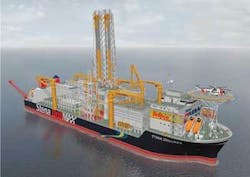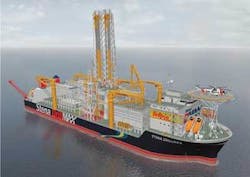DEEPWATER DRILLING: Fasttrack construction schedule for harsh environment drillships
Stena Drilling has commissioned two new Drill-MAX drillships from Samsung Heavy Industries, the first of which is due to be delivered next year. Each vessel represents the company’s largest single investment to date.
The project has developed very quickly. Steel cutting for the first vessel started just 18 months after the company identified a niche in the market for ultra-deepwater exploration in harsh environments such as the Norwegian and Barents Seas: both vessels will be capable of drilling to 10,000 m subsurface in water depths of up to 3,000 m. The contract award was issued less than six months after committing to the investment and subsequent technical discussions, and design work prior to the start of construction was completed within 11 months.
“After talks with a number of shipyards, we soon decided that it was Samsung we wanted as a partner in this project,” said Harry Robertson, Stena’s technical director. “The Geoje yard in South Korea has experience of building drill ships for mild and harsh environments, and its track record for on-time deliveries is excellent.”
Both vessels will cost around $600 million to build, but costs should soon be recouped if rig rates stay at their current levels. Total chartered Stena Drilling’s semisubmersibleStena Tay earlier this year for four years at a day-rate of $425,000.
The first of the newbuild vessels is due to be completed on Dec. 30, 2007, and has already been secured by Repsol-YPF on a four-year charter. The other vessel should be operational in June 2008.
According to Robertson, “the Drill-MAX project is a significant challenge for the Samsung shipyard, as it involves coordinating its offshore division with one of its shipbuilding divisions. Samsung therefore appointed a single project leader with competence in both areas, and he is formally our only contact person from the company for this entire project.”
Ship vs. semi
Stena Drilling believes a drillship offers numerous advantages over a semisubmersible rig, one of the most important being speed. The Drill-MAX will be able to travel at up to 12 knots, compared with just 5-8 knots for a semi, bringing substantial improvements in transit times between drilling locations.
The new design will also have a deck load capacity of 20,000 tons; more than double that of a comparable semisub. Its deck space is three times larger, and its storage capacity is also greater. “All this adds up to a unit capable of operating at locations with poor supply infrastructure,” Robertson said.
A drillship is typically also quicker to build, he added, and a ship design has favorable economic factors. For instance, it is cheaper to fabricate and its lower fuel consumption makes it more economic in operation. One disadvantage is motions in harsher environments, which are slightly better on a semisub.
The Drill-MAX construction is based on theSaipem 10000 design, although this was originally engineered for mild environments - so several alterations and new features have had to be incorporated. Samsung has handled engineering of the new vessels under the supervision of Stena’s technical department.
Both vessels will be capable of a variety of tasks, including batch drilling of multiple well clusters; completions; well tests and interventions; surface BOP operations; extended well tests; and subsea equipment installations.
Stena designed the hydraulic drill package in association with National Oilwell, which was also responsible for the drilling equipment on theStena Don and Stena Tay. Of the current 13 drillships on order worldwide, only five will incorporate dual drilling towers or dual masts. According to Stena’s calculations, the dual mast designs brings big operational improvements for both development and exploration drilling, compared with the performance of a fifth generation single-derrick semi.
The Drill-MAX’s forward auxiliary mast has a lifting capacity of 600 tons, which is used for the initial spud operation through the forward well bay. The riser is made up at the same time, and on completion of the spud, the vessel moves forward, allowing drilling to get under way through the aft well center, where the lift capacity is 1,000 tons.
The new vessels will be built to DNV classifications, and will comply with all current Norwegian sector regulations. They will feature DP-3 capability, with three independent engine rooms, and six 5.5 MW azimuth thrusters. The DP notation will allow them to drill at maximum performance with a wind speed of 27 m/s and a significant wave height of 6.7 m, even with two thrusters out of service. With drilling on standby, the vessels can still be connected even with a significant wave height of 11.5 m and wind speeds of 31 m/s.
The vessels are being constructed to withstand significant wave heights of 16 m, wind speeds up to 41 m/s, and temperatures down to -20° C. They will also be able to store 15,000 cu m of crude during extended well tests.
This article by Rolf Nilsson first appeared in the June 16th edition of the Scandinavian Shipping Gazette, and has been re-printed with permission.

